Dell XPS 410: Core 2 Duo for the Masses
by Jarred Walton on September 18, 2006 12:20 PM EST- Posted in
- Systems
Externals and Appearance
We said that the 2407WFP display is probably the most impressive part of the configuration we were sent for testing. However, the system design is really good as well. Almost everything is completely tool-less, and accessing the internals and changing components is extremely easy. Let's start with the outward appearance first.
In a break from tradition, the case is all white with the Dell logo embossed on the sides. After seeing many beige, black, and varying other colors of cases, the pure white design is a nice change. Some might say that Dell seems to be copying the white appearance of Apple's iMac computers, but if you are looking to copy aesthetics there are far worse choices than Apple.
The front panel is a more traditional design, with black drive bays set in a silver mold. At the top of the case is a chrome XPS 410 logo, and at the bottom are the air intakes for one of the internal fans. Above the Dell logo, you can see the power switch, and you also have access to the front audio ports, two USB ports, and a FireWire port (provided you get the optional FireWire PCI card).
The left and right sides of the case are virtually mirror images of each other. The only difference is that the right side has some ventilation slots at the bottom of the case. If you're wondering about the black cutout towards the front of the case, that is part of the BTX design Dell has used. This provides an air intake for the main 120mm fan that cools the CPU heatsink and also provides ventilation to the inside of the case. Some form of ducting could have been used instead, so the cutout seems to be more for adding visual flair than because it was absolutely required.
Besides the typical connectors you would find at the rear of any PC, there are a few interesting points about the Dell XPS 410. First, note how there's a huge ventilated area in the middle section of the case. This matches up with the 120mm fan located at the front of the case, with the CPU heatsink sitting in the middle. Basically, this provides a great way for getting all of the hot air generated by the CPU and other components out of the system. You can also see that the standard I/O panel is dramatically different from what most people are used to. There are no PS/2 keyboard or mouse ports, nor are there serial or parallel ports. Instead, you get six USB 2.0 ports, a Gigabit Ethernet port, and an S/PDIF optical out connection. Above the S/PDIF port are the audio ports, which are hidden by a small cover by default. If you use the system as an entertainment center PC, the optical out would be the preferred connection, though most people will more than likely use analog speakers.
The last two items worth noting on the rear of the case are better viewed from a different angle. At the top you can see the latch that pops open the right side of the case. This makes it extremely easy to open up the system for upgrades or maintenance. At the bottom just above the expansion card slots you can see a protruding hinge. We will take a closer look at how this works when we get to the internals next, but basically it's part of the tool-less design that allows you to install or remove expansion cards very easily.
We said that the 2407WFP display is probably the most impressive part of the configuration we were sent for testing. However, the system design is really good as well. Almost everything is completely tool-less, and accessing the internals and changing components is extremely easy. Let's start with the outward appearance first.
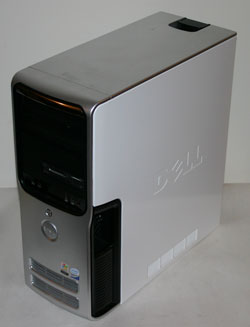 |
| Click to enlarge |
In a break from tradition, the case is all white with the Dell logo embossed on the sides. After seeing many beige, black, and varying other colors of cases, the pure white design is a nice change. Some might say that Dell seems to be copying the white appearance of Apple's iMac computers, but if you are looking to copy aesthetics there are far worse choices than Apple.
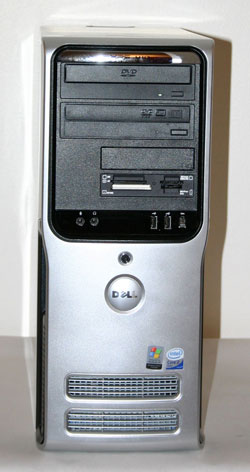 |
| Click to enlarge |
The front panel is a more traditional design, with black drive bays set in a silver mold. At the top of the case is a chrome XPS 410 logo, and at the bottom are the air intakes for one of the internal fans. Above the Dell logo, you can see the power switch, and you also have access to the front audio ports, two USB ports, and a FireWire port (provided you get the optional FireWire PCI card).
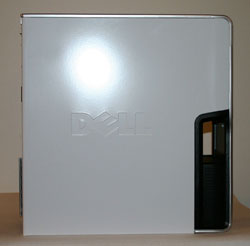 |
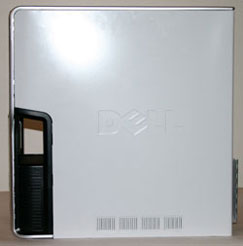 |
| Click to enlarge | |
The left and right sides of the case are virtually mirror images of each other. The only difference is that the right side has some ventilation slots at the bottom of the case. If you're wondering about the black cutout towards the front of the case, that is part of the BTX design Dell has used. This provides an air intake for the main 120mm fan that cools the CPU heatsink and also provides ventilation to the inside of the case. Some form of ducting could have been used instead, so the cutout seems to be more for adding visual flair than because it was absolutely required.
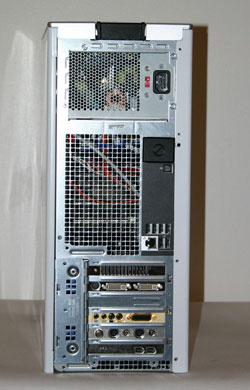 |
| Click to enlarge |
Besides the typical connectors you would find at the rear of any PC, there are a few interesting points about the Dell XPS 410. First, note how there's a huge ventilated area in the middle section of the case. This matches up with the 120mm fan located at the front of the case, with the CPU heatsink sitting in the middle. Basically, this provides a great way for getting all of the hot air generated by the CPU and other components out of the system. You can also see that the standard I/O panel is dramatically different from what most people are used to. There are no PS/2 keyboard or mouse ports, nor are there serial or parallel ports. Instead, you get six USB 2.0 ports, a Gigabit Ethernet port, and an S/PDIF optical out connection. Above the S/PDIF port are the audio ports, which are hidden by a small cover by default. If you use the system as an entertainment center PC, the optical out would be the preferred connection, though most people will more than likely use analog speakers.
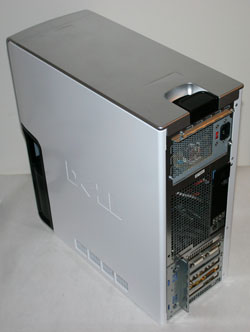 |
| Click to enlarge |
The last two items worth noting on the rear of the case are better viewed from a different angle. At the top you can see the latch that pops open the right side of the case. This makes it extremely easy to open up the system for upgrades or maintenance. At the bottom just above the expansion card slots you can see a protruding hinge. We will take a closer look at how this works when we get to the internals next, but basically it's part of the tool-less design that allows you to install or remove expansion cards very easily.










50 Comments
View All Comments
OptimisTech - Tuesday, September 19, 2006 - link
Anyone know how this differs from the Dimension 9200 in the Small Business division? It seems like the 9200 can be a little cheaper, but they seem identical.JarredWalton - Tuesday, September 19, 2006 - link
The XPS 410 and the Dimension 9200 are the same basic system. The XPS simply comes with higher default components as well as some extra options in a few areas, while the 9200 has some lower end options that help to cut costs (i.e., by default it only ships with one DVD-ROM/CD-RW combo drive and an 80 GB hard drive, and DDR2-667 memory isn't listed as an upgrade). Also note that you do not get a higher level of technical support with the Dell dimension 9200 I think (though that might be wrong, as the 9200 is a business setup).Kougar - Monday, September 18, 2006 - link
Definitely looking forward to it! 15" viewable is just not cutting it for me anymore...
If I may ask, what other monitors might be in the article featuring the 2407WFP review or others? I have seen a review of the relatively hard to find 24" BenQ FP241W, which outscored the 2407WFP, but as I know nothing of the site I'd very much like to see one of Anandtech's solid reviews comparing it to the Dell model. Just another suggestion, anyway... ;)
JarredWalton - Monday, September 18, 2006 - link
Honestly, a large part of LCD purchase decisions is going to come down to price, especially on 23/24" models. While a display may be twice as accurate, for everything but professional use that probably won't matter much. I've got both the old and new Dell 24" models (I bought the 2405FPW last year), a 23" Philips, as well as a few smaller, less-expensive displays in the 19-22" range. If the price is equal or close, get the better quality display of course, but there is very little to complain about with Dell's 24" LCDs in my experience.Kougar - Monday, September 18, 2006 - link
Thank you for your reply!I didn't want to make a huge post, but a few things I probably should of pointed out that confuse the issue is that The BenQ is supposed to be cheaper, although at the moment it's about a little more in US dollars. In pounds it's a good deal cheaper though according to their review, which is partly why they scored it so well. But it's still pretty rare/new, so I figure prices will still be setlling on it.
According to Trusted Reviews it's £549.99 without VAT, much below the Dell which they say is £702.00 without VAT. And also according to them better quality, enough for a perfect score across the board. Naturally TrustedReviews didn't score the 2407WFP half as well, so I'm trying to figure out which is indeed better for gaming purposes in response timings and such. ;)
What you've said pretty much sums up what I've read about the Dell 2407WFP, which is mostly why I find their ratings of that BenQ and it's purported price to be so hard to believe!
JarredWalton - Monday, September 18, 2006 - link
I do have one BenQ LCD, but it's only a 19" model. I feel BenQ is a little cheaper on build quality, and I did have a 20" model for a bit that started emiting a high-pitched squeal at times. I haven't done the specific tests on the 19" model yet, but most 23/24" LCDs are very similar, as there aren't that many panel manufacturers. I'd be surprised if the BenQ is substantially better, but if you can find it for less money it's certainly worth considering. I'm trying to get a 24" Acer for review as well, as it's priced about $100 lower than the Dell 2407WFP.Kougar - Monday, September 18, 2006 - link
Yipe, those things can squeal? I would not feel comfortable sitting infront of any monitor that squealed!Thank you again, I do aprpeciate your opinion and experiences with both company's line of displays.
And good luck getting that Acer, I'll add that one to my list! I'm planning on getting some kind of 22-24" widescreen display during the prime time sales season, but it really helps to have a good idea of what's out there already. Thanks again!
JarredWalton - Tuesday, September 19, 2006 - link
It's usually a transistor or capacitor or something that causes the noise. A lot of motherboards do it as well in my experience, but the pitch and volume of the noise from this particular LCD was louder than most others that I've encountered.Sunrise089 - Monday, September 18, 2006 - link
Top of page 5 reads "One final at them to talk about is the included TV tuner""At them" should = "item"
I couldn't figure out how you would have mistyped that, but then I remembered that speech-recognition software review you did. Looks like that still isn't a perfected system :)
JarredWalton - Monday, September 18, 2006 - link
I do have to be very thorough about proofreading my articles, but after being up all night finishing up this review I missed that one. When I go through and do the final read before posting an article, I often encounter several spots for a look at the words and think, "what on earth did I say to get Dragon NaturallySpeaking to write that!?"Anyway, thanks for the correction. Hopefully that's the last one. :-)